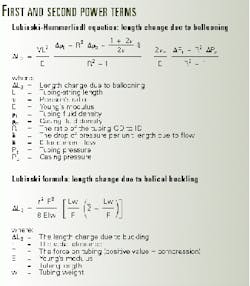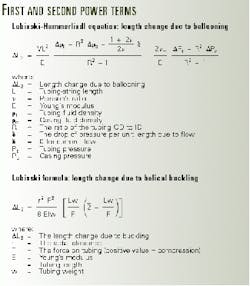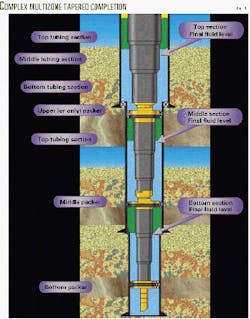Tubing completion analysis corrects computational errors
A thorough analysis of tubing-completion design, which takes into account the differences between single and multiple strings, can reduce or eliminate planning and operational errors.
Every year, companies spend millions of dollars in drilling wells, only to see their investment impaired or even wasted because of a failure in the completion system, caused more often than not by inadequate tubing string analysis.
When a completion fails, it is usually for one of three reasons:
- Human error in building and running the tools or tubing string.
- Well conditions changing in ways unforeseen before the completion was designed.
- Inadequate completion system design or tubing-string analysis, mainly caused by an outdated or poorly designed tubing-string analysis program.
While engineering analysis cannot negate the effects of human error or changing well conditions, it can be applied to improve tubing-string analysis programs.
Prior programs
Nearly 40 years ago, Lubinski, Althouse, and Logan set forth basic the equations, principles, and procedures that have formed the basis of tubing-string analysis programs, expanded upon 13 years later by Hammerlindl.1 2
Although the tenets set forth in these papers remain applicable, particularly for uniform, single-string completions, many analysis programs based on those tenets inadequately describe or predict today's complex completions.
There are several explanations for these inadequacies. For example, some programs do not consistently adhere to the basic principles described by Lubinksi, while others use a few equations but not the complete process.
If programming equations do not look at the system as a whole-or do not question whether an equation applies under certain conditions-incomplete yield analysis may result under certain conditions that can lead to misleading and occasionally disastrous results.
Sum of the parts
Advancing from a single-string completion analysis to a combination-string completion analysis, using the same formulas but applying the principle of superposition, can create errors.
This principle, which evolved through the property of linear functions states that the sum of two or more solutions is also a solution, can only be applied to linear first-power terms.
The equation (see accompanying box) describes the length change caused by ballooning, which affects single and multiple string design.
This equation was first proposed by Lubinski for single tubing strings and then adapted by Hammerlindl for combination tubing strings.1 2 It is clear here that the first term is a second power term (L2) and that the second term is a first power term (L). Because the principle of superposition can only be applied to linear terms, attempting to apply it to a combination string is a mathematical mistake (Fig. 1).
For example, if a single string is considered as three equal but separate pieces, then the sum of each part of a first power term is 1/3 + 1/3 + 1/3 = 1. These terms are linear and therefore superposition applies. The sum of the parts of a second-power term is (1/3)2 + (1/3)2 + (1/3)2 = 1/3. Thus, these terms are not linear, superposition does not apply, and the sum of the parts does not equal the whole.
The correct method
To answer the question of whether the currently accepted method is correct, the following example has been provided for calculation purposes only.
A tubing string, made up of 9,000 ft of 27/8-in., 6.5 lb/ft N-80, tubing is landed, with both casing and tubing filled with 10-ppg brine. The tubing fluid is then displaced with a 15-ppg fluid, and a pressure of 1,000 psi is then applied to the tubing.
Analyzing the tubing as a single string results in the tubing string being shortened by about 12 in., a result of ballooning. On the other hand, applying the principle of superposition, as suggested in the literature, assumes three sections of 3,000 ft each, and results in a tubing string shortened by 7.75 in.
It should be noted that if the initial and final fluids in both the casing and the tubing are of the same density, Hammer- lindl's equation results in the correct answer. However, such an occurrence rarely occurs in real well conditions.
The following questions and others should be considered when taking formulas meant for one uniform string then applying these to a complex system:
- Is the error in the accepted method satisfactory?
- What happens if the tubing is latched and the resulting forces are then analyzed?
- Would a 10,000-lb force difference on the tubing string affect the design?
Correcting a misnomer
Classic theory for tubing-string analysis refers to a resultant stress in the tubing, which accounts for axial and bending loads as "corkscrew stress." This label can be misleading when instead the term "tri-axial stress" should be applied, especially as the term "corkscrew" implies helical or sinusoidal buckling.
It is possible to have a positive value for "corkscrew stress" without the effect of buckling and with a perfectly straight tubing string. But it is misleading to imply there is any "corkscrew" effect in a (potentially) perfectly straight tubing string.
Buoyancy effects
There are two schools of thought regarding buoyancy effects on completion systems:
- Archimedes' principle, as used by Lubinski, states that when a body is submerged in a fluid, this body will be buoyed by a force equal to the weight of the displaced fluid. This force can be represented as acting through the center of the mass of the displaced fluid.
- Pascal's law, on the other hand, states that an external pressure applied to a fluid in a closed vessel is uniformly transmitted throughout the fluid. Subscribers to this philosophy estimate the force at the end of the tubing string as a product of the pressure times the cross-sectional area for which the pressure is acting upon; in this case, the cross-sectional area of the tubing end.
In many cases, both Archimedes' and Pascal's principles yield the same answer; however, the Pascal-based school of thought poses difficulties when the fluid in the tubing is of a different density than that found in the casing, which is most often the case.
For example, the operator in a recent case study made three attempts to complete an offshore well with hydraulically set dual-string packers, each time using a different manufacturer's packer. Each of the identically configured packers used a 23/8-in., 4.7 lb/ft long string and a 27/8-in., 6.5 lb/ft short string. Workers ran both tubing strings simultaneously, with great care taken to maintain weight balance between the strings so as not to cause problems while setting the packer.
The casing was full of 10-ppg fluid and the operator's completion procedure called for running the packer to 10,000 ft, then displacing the fluid in the 27/8-in. tubing with nitrogen just before setting the packer. Three service companies, however, failed to complete the well in this manner.
Initially, crews filled both the casing and the tubing with the 10-ppg fluid and the tubing weighed approximately 55,600 lb, with a buoyancy effect of 9,400 lb. Application of either Archimedes' or Pascal's principle to the initial conditions yielded identical results.
The final conditions, however, called for displacing the fluid in the tubing with nitrogen. This displacement required a pressure of about 3,700 psi to be applied at the wellhead in order to maintain a pressure of 5,200 psi at the bottom of the tubing, resulting in a tubing fluid gradient of about 0.15 psi/ft or 2.89 ppg.
Under these conditions, the answer based on Pascal's principle remains the same as it is the same 5,200 psi of force that acts on the same cross-sectional end area of the tubing as set up under the initial conditions. According to Archimedes' principle, however, the buoyancy effect is 65,000 lb of steel plus 7,020 lb of nitrogen minus 33,720 lb of the displaced fluid.
The resulting tubing string then weighs 38,300 lb with a buoyancy effect of 26,700 lb, as compared to the 9,400 lb using Pascal's principle. As a result of this miscalculation, completion failure happened three times in the same well before correct analysis of the buoyancy effect provided a solution.
Corrections to buckling
One of the many contributions Lubinski made to tubing-string analysis is the formula for calculating length change due to helical buckling (accompanying box).
The factor in the bracket only applies when the tubing is completely buckled; otherwise the equation consists of only the first part.
This equation is valid for most completions under normal circumstances. From a mathematical point of view, if the tubing string is totally buckled, the formula will give a value of 0 when Lw/F = 2 and a positive value when Lw/F > 2.
In reality, it is virtually impossible to buckle a tubing string completely and have a zero or positive length change occur due to buckling.
And in a homogeneous single-string completion under well conditions, it is rare to have the neutral point of a string of tubing above the surface (top of the tubing string). This would require an extremely high slack-off force, a high tubing-to-casing pressure difference, or a combination of both.
Hammerlindl and others have used the same equation in the combination string completion. For example, a string with three sections of 3,000 ft each, with a total length of 9,000 ft, may result in completion failure.
Assume that initial calculations show the neutral point at 4,500 ft. This means that the bottom section is completely buckled, the middle section is partially buckled, and the top section is not buckled at all.
It is possible to apply the helical buckling equation for the bottom section to obtain a positive length change greater than the length change in the middle section, with the overall result of positive total length change due to buckling.
If the same string is analyzed as one uniform string, only the first part of the equation applies, and the length change due to buckling becomes negative, providing the correct answer. This is one more case in which the sum of the parts does not equal the whole. For example, how can 4,500 ft of tubing string be buckled and at the same time become longer?
Raising more questions
In just about every program, other than those dealing with coiled tubing, the entire amount of slack-off force (or tension) that is applied at the wellhead presumably reaches the packer.
This would happen, however, only if the hole and tubing is perfectly vertical and straight-a near-impossible occurrence. If it does not meet these criteria, then the tubing will rub against the casing and transfer some of the slack-off force to the casing.
How much friction there is between the tubing and casing depends on the above factors, and especially on how much the tubing string is buckled. The only question then is not whether some of the slack-off force is transferred to the casing, but how much.
Will this contribution, due to friction, buckling, and wellbore inclination, result in a more conservative design, adding an extra safety factor? Or, will the completion fail because some of the slack-off force does not reach the packer? Either scenario can be applied, and only a more-detailed analysis of the system as a whole can determine the right answer.
In addition, the slack-off equation, used to calculate the weight that reaches the packer, accounts for Hooke's law-in which the stress on a solid substance is directly proportional to the strain produced, provided the stress is less than the elastic limit of the substance-and buckling, but does not account for length.
All other buckling formulas account for length. The erroneous assumption in the slack-off formula is that slacked-off tubing is always buckled regardless of length. Consider slacking off on a packer 1 ft below the wellhead. Is that tubing buckled?
One other accepted term that bears more careful analysis is "top joint tension." The most common procedure is to start with the tubing weight of the string in air and subtract the packer-to-tubing force and the actual force due to pressure.
Yet how often is the tubing string totally suspended in air? Since the tubing string is already in fluid, should not the tubing weight in fluid be considered instead? Does the "accepted" method give a very conservative answer, adding to the already-included safety factor?
Addressing the limitations
Several tubing-string analysis programs are currently available. In general, all these programs perform an adequate evaluation for uniform, single-string completions.
A more advanced program that was recently developed, however, can provide a tubing-string analysis for combination completions of up to three stacked packers and tapered tubing strings, with up to three different tubing and casing sizes per section.
The program's input and output are laid out in a top-down, left-to-right method, making it very intuitive and easy to follow. Where entries are not self-descriptive, notes are made so that the user enters the correct data. The output goes beyond displaying the basic information of length changes and forces on the tubing and packer.
It displays all the information necessary to make a sound engineering decision when the "accepted" methods do not apply. It also gives the user the ability to see instantaneously how a single change in the design will affect the output, without having to reenter all the data. In order not to confuse which input goes with what output, a tracking number is assigned to both.
The advanced tubing-string analysis program is quite rigorous as the tubing-string analysis methodology goes beyond taking the accepted techniques, namely the findings of Lubinski and Hammerlindl.
The program analyzes every equation and step, looking first at the individual pieces of the system, then comparing the results to the whole system to ensure that the sum of the parts equals the whole.
Where such solutions are not possible at the moment, questions are raised, and by looking at both the parts of the system and the system as a whole, a more fundamentally sound solution can be provided.
References
- Lubinski, A., Althouse, W.S., and Logan, J.L., "Helical buckling of tubing sealed in packers," SPE paper presented at 36th Annual Fall Meeting, Dallas, Oct. 8-11, 1961.
- Hammerlindl, D.J., "Movement, forces, and stresses associated with combination tubing strings sealed in packers," Journal of Petroleum Technology, February 1977, p. 195.
The authors
Dale Fain is the technical services manager for Weatherford Completion Systems. Prior to that, he worked for Zilkha Energy in Oklahoma City. He holds an Associate of Arts from the University of North Dakota, Williston, in mathematics and chemistry.
Patrick Hyde is principal engineer at Hyde Engineering Co., a Fort Worth-based consulting firm. He holds a BME in mechanical engineering from the University of Minnesota (1973) with graduate work at the University of Michigan. Hyde is a registered professional engineer in Texas.
Andronikos Demarchos is an engineer with M. J. Economides Consultants Inc. of Houston. Prior to that, he worked for Union Pacific Resources of Fort Worth. He holds a BS in electrical engineering from the university of Houston (1994) and an MS in petroleum engineering from Texas A&M University (1998).




